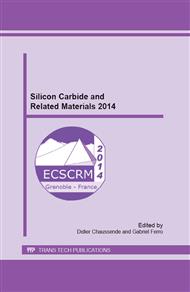p.528
p.533
p.537
p.541
p.545
p.549
p.553
p.559
p.563
Effect of Surface Damage on SiC Wafer Shape
Abstract:
The flatness of a silicon carbide wafer in terms of bow and warp is the result of the combination of factors both material and process related. Sub-surface damage (SSD) from the wafering process steps can be considered as a thin film under compressive stress on the wafer surface. SSD is generally decreased with each subsequent processing step after the multiwire saw. Single-sided process steps can produce very different levels of SSD on opposing wafer surfaces, leading to high bow and warp values. The present study investigates the effects of SSD on wafer flatness at various process steps as well as methods to minimize shape effects due to SSD during and after processing.
Info:
Periodical:
Pages:
545-548
Citation:
Online since:
June 2015
Keywords:
Price:
Сopyright:
© 2015 Trans Tech Publications Ltd. All Rights Reserved
Share:
Citation:


